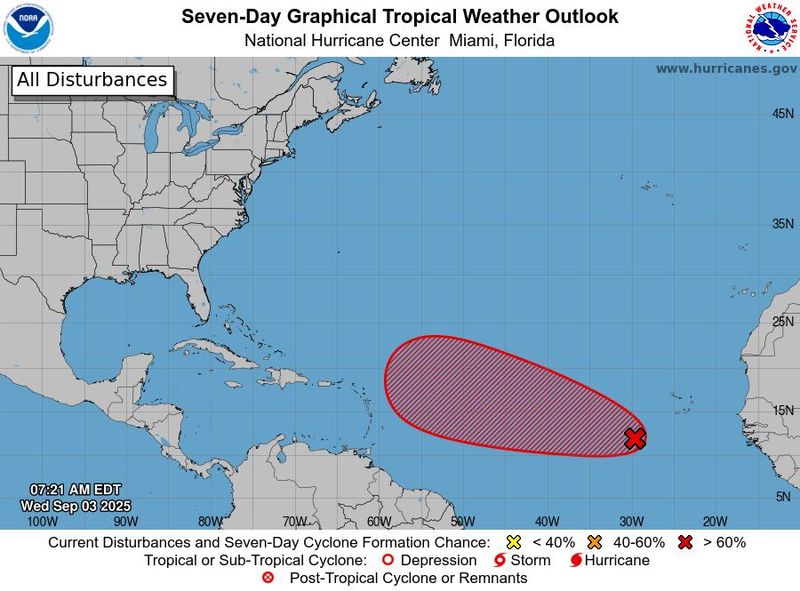September is the most active month of the Atlantic hurricane season, with the peak arriving Sept. 10.
The tropics have been quiet since Tropical Storm Fernand formed Aug. 23, but don’t let the current lull lure you into a false sense of security.

➤ Track all active storms
➤ Weather alerts via text: Sign up to get updates about current storms and weather events by location
Activity is expected to ramp up, and a disturbance in the eastern Atlantic is likely to become a tropical depression later this week or weekend, according to the National Hurricane Center.
AccuWeather forecasters are predicting it could become Tropical Storm Gabrielle before the weekend and could even become a hurricane by the end of the weekend.
➤ What does history tell us about Florida and September hurricanes? Will you be surprised?
In the eastern Pacific, forecasters are watching two hurricanes: Kiko and Lorena.
Kiko is expected to become a major hurricane today east of Hawaii. Lorena also is expected to strengthen and could bring heavy rainfall to Arizona late Wednesday through Sept. 5, according to the National Hurricane Center.
Here’s the latest advisory from the National Hurricane Center as of 2 a.m., Wednesday, Sept. 3.
What tropical waves, disturbances are in Atlantic basin now? Will we see Tropical Storm Gabrielle?
Another tropical wave:
Are there any hurricanes coming to Florida?
It’s still too early to tell where the tropical wave in the eastern Atlantic will go. The National Hurricane Center hasn’t even designated it as an invest as of Wednesday morning.
AccuWeather Hurricane Expert Alex DaSilva said the most likely days for strengthening would be between Sept. 4-6.
“Due to large amounts of dry air currently in the region, any tropical development and strengthening would likely be gradual. But, it’s possible that anything that forms could ramp up to a hurricane by the end of the weekend,” DaSilva said.
When is tropical activity expected to increase?
“While there will be a relative lull in tropical activity during the first few days of September, atmospheric conditions will become a lot more conducive for development later this week and into next week,” said DaSilva.
More tropical waves are expected to move off the coast of Africa. With less dust and dry air in the way, it’s likely more of these waves will strengthen, according to AccuWeather.
Warm waters means tropical development so watch Gulf closely
The Gulf will also bear watching, AccuWeather forecasters warned.
“With very warm waters, the Gulf could fuel the rapid strengthening of any tropical system that develops or moves into the region.”
What is an invest?
Short for investigation, the National Hurricane Center uses the term invest for areas of low pressure it is monitoring for potential development into a tropical depression or storm.
Invests are not tropical depressions or tropical storms. They’re usually clusters of showers and thunderstorms, and just because they’ve been designated as an invest does not guarantee they’ll strengthen into a tropical storm or hurricane.
Invests run from 90 to 99, followed by a letter: L for the Atlantic basin and E for those in the eastern Pacific. After 99, it starts over again and the next invest would be 90.
Once something has been designated as an invest, specialized data sets and computer models can begin, including scheduling Hurricane Hunter aircraft missions and running spaghetti models.
What do the colored, hatched areas on the NOAA map mean?
The hatched areas on the National Hurricane Center’s tropical outlook map indicate “areas where a tropical cyclone — which could be a tropical depression, tropical storm or hurricane — could develop,” said National Hurricane Center Deputy Director Jamie Rhome.
The colors make it visibly clear how likely a system could develop, with yellow being low, orange medium, and red high.
The National Hurricane Center generally doesn’t issue tropical advisories until there is a named storm, but there is an exception.
“If a system is near land and there is potential for development, the National Hurricane Center won’t wait before it issues advisories, even if the system hasn’t become an actual storm. This gives residents time to prepare,” Rhome said.
Who is likely to be impacted by the tropical waves out there?
It’s too early at this time to determine if there will be any impact to Florida or the U.S. from the tropical waves in the Atlantic.
➤ Excessive rainfall forecast
Forecasters urge all residents to keep an eye on the tropics and to always be prepared.
Need hurricane supplies? Those are tax free all year
Officials regularly encourage Florida residents to prepare for storms before a hurricane is approaching, while shelves are fully stocked and you aren’t battling crowds all rushing to the store at the same time.
➤ Don’t have a hurricane supply kit? From the basics to the extras, here’s what you need
“It only takes one storm to make it an impactful year for your community,” the National Hurricane Center Miami posted on X. “Hurricane season is a marathon, not a sprint.”
➤ See list of emergency supplies you can now buy tax free
On Aug. 1, specific hurricane supplies became permanently tax-free in Florida, ranging from batteries to generators.
Florida weather radar for Sept. 3, 2025
Weather watches and warnings issued in Florida
When is the Atlantic hurricane season?
The Atlantic hurricane season runs from June 1 through Nov. 30.
Ninety-seven percent of tropical cyclone activity occurs during this time period, NOAA said.
The Atlantic basin includes the northern Atlantic Ocean, Caribbean Sea and Gulf of America, as the Gulf of Mexico is now known in the U.S. per an order from President Trump. NOAA and the National Hurricane Center are now using Gulf of America on its maps and in its advisories.
When is the peak of hurricane season?
The peak of the season is Sept. 10, with the most activity happening between mid-August and mid-October, according to the Hurricane Center.
Hurricane names for 2025 season
Here are the names for the 2025 Atlantic hurricane season, along with how to pronounce them. The first hurricane of the season typically forms Aug. 11.
National Hurricane Center map: See what forecasters watching now
Systems currently being monitored by the National Hurricane Center include:
Why does NHC say ‘tropical cyclone’ on its maps instead of hurricane or tropical storm?
Tropical cyclone is the generic term used by the National Weather Service, NOAA and the National Hurricane Center for any tropical system, even if it’s in the tropical Atlantic basin.
To be more precise, a tropical cyclone is a “rotating, organized system of clouds and thunderstorms that originates over tropical or subtropical waters and has closed, low-level circulation,” NOAA sadi.
Once maximum sustained winds reach 74 mph, what it is called is determined by where it originated:
Interactive map: Hurricanes, tropical storms that have passed near your city
Stay informed. Get weather alerts via text
What’s next?
We will update our tropical weather coverage daily.
Download your local site’s app to ensure you’re always connected to the news. And look for our special subscription offers here.
This story has been updated to include new information.
This article originally appeared on Sarasota Herald-Tribune: Tropical depression likely later this week. Will it become Tropical Storm Gabrielle or hurricane?
Reporting by Cheryl McCloud, USA TODAY NETWORK – Florida / Sarasota Herald-Tribune
USA TODAY Network via Reuters Connect



